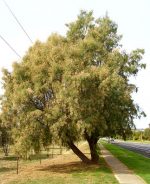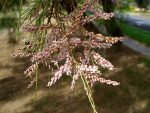A lso known as Athel pine, this evergreen tree is native to arid and semi-arid subtropics and tropics in Africa, Middle East and parts of southern and western Asia where it grows along watercourses. It is a member of the Tamaricaceae, a small family of 78 species. Growing from a deep and extensive root system, the tree grows rapidly up to 60′ tall and wide and has a dense crown with many stout branches and long weeping twigs. The bark of young plants is smooth and reddish but turns brown and furrowed with maturity. The tiny, blue-green, overlapping scale-like leaves exude salt which may form a crusty layer on the surface that drips to the ground. Two inch long spike-like clusters of small pink to white flowers appear from spring to fall and give way to tiny seed capsules with a small tuft of hair. Photo Credit Bidgee-Wikipedia
lso known as Athel pine, this evergreen tree is native to arid and semi-arid subtropics and tropics in Africa, Middle East and parts of southern and western Asia where it grows along watercourses. It is a member of the Tamaricaceae, a small family of 78 species. Growing from a deep and extensive root system, the tree grows rapidly up to 60′ tall and wide and has a dense crown with many stout branches and long weeping twigs. The bark of young plants is smooth and reddish but turns brown and furrowed with maturity. The tiny, blue-green, overlapping scale-like leaves exude salt which may form a crusty layer on the surface that drips to the ground. Two inch long spike-like clusters of small pink to white flowers appear from spring to fall and give way to tiny seed capsules with a small tuft of hair. Photo Credit Bidgee-Wikipedia
The Hebrew word seechim is usually translated as bush or shrub and is thought to refer to one of three species of Tamarix tree: T. articulata, T. pentandra, and/or T. tetragyna. In addition, the Hebrew word eshel, usually translated as grove, tree, shrub, wood, or tamarix, could also be one of these three species of Tamarix.
Genesis 21: 15 (NIV) As Hagar and Ishmael traveled away from Abraham their supplies ran out and they expected to die.
“When the water in the skin was gone, she put the boy under one of the bushes.”
Genesis 21:33 (NIV) After making a treaty with Abimelech….
“Abraham planted a tamarisk tree in Beersheba, and there he called on the name of the LORD, the Eternal God.”
I Samuel 22:6 (NIV) Four hundred discontented men came to David.
“Now Saul heard that David and his men had been discovered. And Saul was seated, spear in hand, under the tamarisk tree on the hill at Gibeah, with all his officials standing at his side.”
I Samuel 31:13 (NIV) After the Philistines killed Saul and his sons, the men of Jabesh Gilead took their bodies and prepared them for burial.
“Then they took their bones and buried them under a tamarisk tree at Jabesh, and they fasted seven days.”
 Athel tree likes full sun and lean, dry soil in USDA Hardiness Zones 8-11 and tolerates saline and alkaline conditions. It is susceptible to mites, galls, and moths. Propagation is by seed, division of sprouts and broken limbs. Trees are valued as ornamentals, shade trees, windbreaks, and barriers to fire. They are harvested for food, medicine, tannins, and timber.
Athel tree likes full sun and lean, dry soil in USDA Hardiness Zones 8-11 and tolerates saline and alkaline conditions. It is susceptible to mites, galls, and moths. Propagation is by seed, division of sprouts and broken limbs. Trees are valued as ornamentals, shade trees, windbreaks, and barriers to fire. They are harvested for food, medicine, tannins, and timber.
The genus name, Tamarix, is derived from the Tamaris River in Spain. The specific epithet, aphylla, comes from the Greek a- , meaning lacking, and phylla, meaning leaf, referring to leafless look of the branches. The specific epithet, articulata, is the Latin word meaning jointed.
Photo Credit -Bidgee-Wikimedia